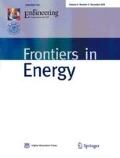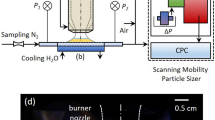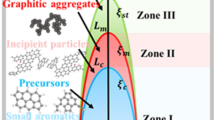Abstract
The evolution of particle size distribution function (PSDF) of soot in premixed flames of benzene and toluene was studied on a burner stabilized stagnation (BSS) flame platform. The cold gas velocities were changed to hold the maximum flame temperatures of different flames approximately constant. The PSDFs of all the test flames exhibited a bimodal distribution, i.e., a small-size nucleation mode and a large-size accumulation mode. It was observed that soot nucleation and particle growth in the benzene flame were stronger than those in the toluene flame at short residence times. At longer residence times, the PSDFs of the two flames were similar, and the toluene flame showed a larger particle size distribution range and a higher particle volume fraction than the benzene flame.
Similar content being viewed by others
References
Brunekreef B, Holgate S T. Air pollution and health. Lancet, 2002, 360(9341): 1233–1242
Omidvarborna H, Kumar A, Kim D S. Recent studies on soot modeling for diesel combustion. Renewable & Sustainable Energy Reviews, 2015, 48: 635–647
Zhao F, Yang W, Zhou D, Yu W, Li J, Tay K L. Numerical modelling of soot formation and oxidation using phenomenological soot modelling approach in a dual-fueled compression ignition engine. Fuel, 2017, 188: 382–389
Resitoglu I A, Altinisik K, Keskin A. The pollutant emissions from diesel-engine vehicles and exhaust after treatment systems. Clean Technologies and Environmental Policy, 2015, 17(1): 15–27
EUR-Lex Website. Council Directive 91/441/EEC of 26 June 1991 amending Directive 70/220/EEC on the approximation of the laws of the Member States relating to measures to be taken against air pollution by emissions from motor vehicles. 1991, available at website of eur-lex.europa.eu
EUR-Lex Website. Commission Regulation (EU) No 459/2012 of 29 May 2012 amending Regulation (EC) No 715/2007 of the European Perliament and of the Council and Commission Regulation (EC) No 692/2008 as regards emissions from light passenger and commercial vehicles (Euro 6). 2012-06-01, available at website of eur-lex.europa.eu
Frenklach M, Clary D W, Gardiner W C Jr, Stein S E. Effect of fuel structure on pathways to soot. Symposium (International) on Combustion, 1986, 21(1):1067–1076
Wang Y, Makwana A, Iyer S, Linevsky M, Santoro R J, Litzinger T A, O'Connor J. Effect of fuel composition on soot and aromatic species distributions in laminar, co-flow flames. Part ai]1._Non-premixed fuel. Combustion and Flame, 2018, 189: 443–455
Sidebotham G W, Glassman I. Flame temperature, fuel structure, and fuel concentration effects on soot formation in inverse diffusion flames. Combustion and Flame, 1992, 90(3-4): 269–283
Butler J D, Crossley P. Reactivity of poly cyclic aromatic hydrocarbons adsorbed on soot particles. Atmospheric Environment, 1981, 15(1): 91–94
Sobotowski R A, Butler A D, Guerra Z. A pilot study of fuel impacts on PM emissions from light-duty gasoline vehicles. SAE International Jurnal of Fuels and Lubricants, 2015, 8(1): 214–233
DeWitt M J, Corporan E, Graham J, Minus D. Effects of aromatic type and concentration in Fischer-Tropsch fuel on emissions production and material compatibility. Energy & Fuels, 2008, 22(4): 2411–2418
Short D Z, Vu D, Durbin T D, Karavalakis G, Asa-Awuku A. Components of particle emissions from light-duty spark-ignition vehicles with varying aromatic content and octane rating in gasoline. Environmental Science & Technology, 2015, 49(17): 10682–10691
Richter H, Granata S, Green W H, Howard J B. Detailed modeling of PAH and soot formation in a laminar premixed benzene/oxygen/ argon low-pressure flame. Proceedings of the Combustion Institute, 2005, 30(1): 1397–1405
Bachmann M, Wiese W, Homann K H. Fullerenes versus soot in benzene flames. Combustion and Flame, 1995, 101(4): 548–550
Wei J, Song C, Lv G, Song J, Wang L, Pang H. A comparative study of the physical properties of in-cylinder soot generated from the combustion of n-heptane and toluene/n-heptane in a diesel engine. Proceedings of the Combustion Institute, 2015, 35(2): 1939–1946
Hansen N, Schenk M, Moshammer K, Kohse-Hoinghaus K. Investigating repetitive reaction pathways for the formation of polycyclic aromatic hydrocarbons in combustion processes. Combustion and Flame, 2017, 180: 250–261
Camacho J. Development of a novel heterogeneous flow reactor-Soot formation and nanoparticle catalysis. Dissertation for the Doctoral Degree. Los Angeles: University of Southern California, 2013
Simmons B, Williams A. A shock tube investigation of the rate of soot formation for benzene, toluene, and toluene/n-heptane mixtures. Combustion and Flame, 1988, 71(3): 219–232
Ergut A, Levendis Y A, Richter H, Howard J B, Carlson J. The effect of equivalence ratio on the soot onset chemistry in one-dimensional, atmospheric-pressure, premixed ethylbenzene flames. Combustion and Flame, 2007, 151(1-2): 173–195
Gigone B, Karatas A E, Gulder O L. Soot aggregate morphology in coflow laminar ethylene diffusion flames at elevated pressures. Proceedings of the Combustion I.stitute, 2019, 37(1): 841–848
Maricq M M. A comparison of soot size and charge distributions from ethane, ethylene, acetylene, and benzene/ethylene premixed flames. Combustion and Flame, 2006, 144(4): 730–743
Tang Q, Ge B, Ni Q, Nie B, You X. Soot formation characteristics of n-heptane/toluene mixtures in laminar premixed burner-stabilized stagnation flames. Combustion and Flame, 2018, 187: 239–246
Abid A D, Tolmachoff E D, Phares D J, Wang H, Liu Y, Laskin A. Size distribution and morphology of nascent soot in premixed ethylene flames with and without benzene doping. Proceedings of the Combustion Institute, 2009, 32(1): 681–688
Echavarria C A, Sarofim A F, Lighty J A S, D'Anna A. Evolution of soot size distribution in premixed ethylene/air and ethylene/ benzene/air flames: experimental and modeling study. Combustion and Flame, 2011, 158(1): 98–104
Lin B, Gu H, Guan B, Han D, Gu C, Huang Z, Lin H. Size evolution of soot particles from gasoline and n-heptane/toluene blend in a burner stabilized stagnation flame. Fuel, 2017, 203: 135–144
Shaddix C R. Correcting thermocouple measurements for radiation loss: a critical review. Aibuquerque, NM, 1999, HTD99-HT282
Peterson R C, Laurendeau N M. The emittance of yttrium-beryllium oxide thermocouple coating. Combustion and Flame, 1985, 60(3): 279–284
Shao C, Guan B, Lin B, Gu H, Gu C, Li Z, Lin H, Huang Z. Effect of methane doping on nascent soot formation in ethylene-based laminar premixed flames. Fuel, 2016, 186: 422–429
Lin H, Gu C, Camacho J, Lin B, Shao C, Li R, Gu H, Guan B, Wang H, Huang Z. Mobility size distributions of soot in premixed propene flames. Combustion and Flame, 2016, 172: 365–373
Smooke M D, Puri I K, Seshadri K A. A comparison between numerical calculations and experimental measurements of the structure of a counterflow diffusion flame burning diluted methane in diluted air. Symposium (International) on Combustion, 1988, 21(1): 1783–1792
Kee R J, Miller J A, Evansl G H, Dixon-Lewis G. A computational model of the structure and extinction of strained, opposed flow, premixed methane-air flames. Symposium (International) on Combustion, 1989, 22(1): 1479–1494
Lutz A E, Kee R J, Grcar J F, Rupley F M. OPPDIF: a Fortran program for computing opposed-flow diffusion flames. Sandia National Laboratories, Albu-querque, New Mexico, 1996
Zhao B, Yang Z, Li Z, Johnston M V, Wang H. Particle size distribution function of incipient soot in laminar premixed ethylene flames: effect of flame temperature. Proceedings of the Combustion Institute, 2005, 30(1): 1441–1448
Abid A D, Heinz N, Tolmachoff E D, Phares D J, Campbell C S, Wang H. On evolution of particle size distribution functions of incipient soot in premixed ethylene-oxygen-argon flames. Combustion and Flame, 2008, 154(4): 775–788
Waldmann L. The force of a non-homogeneous gas on small suspended spheres. Zeitshrift fur Naturforschung Section A-A Journal of Physical Sciences, 1959, 14a: 589–599
Li Z, Wang H. Drag force, diffusion coefficient, and electric mobility of small particles II: application. Physical Review. E, 2003, 68(6): 061207
Lai F S, Friedlander S K, Pich J, Hidy G M. The self-preserving particle size distribution for Brownian coagulation in the free-molecule regime. Journal of Colloid and Interface Science, 1972, 39(2): 395–405
Acknowledgements
This work was supported by the National Natural Science Foundation of China (Grant No. 51776124).
Author information
Authors and Affiliations
Corresponding author
Rights and permissions
About this article
Cite this article
Liu, W., Zhai, J., Lin, B. et al. Soot size distribution in lightly sooting premixed flames of benzene and toluene. Front. Energy 14, 18–26 (2020). https://doi.org/10.1007/s11708-020-0663-6
Received:
Accepted:
Published:
Issue Date:
DOI: https://doi.org/10.1007/s11708-020-0663-6




